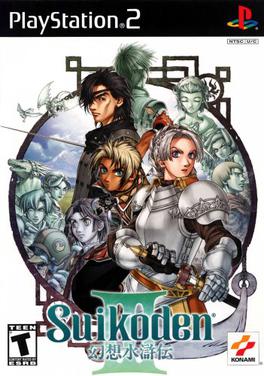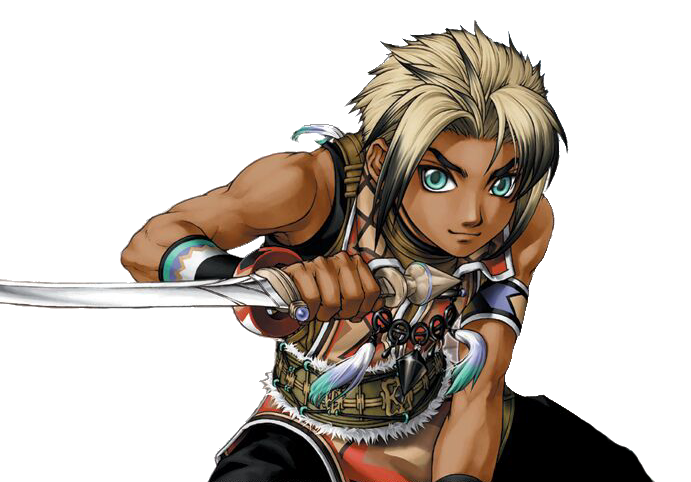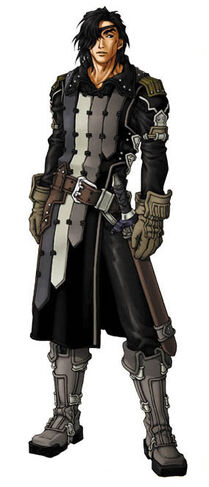Although I adore Suikoden, I must admit that the third entry in the series is one that is rather divisive; you either love it or you hate it, and there are strong arguments that justify both positions. However, one thing that is not up to debate is that Suikoden 3 tried something very different from its predecessors, and in large parts succeeded in telling a very memorable story via a very unique Perspective system that allows the player to go through several Point of View characters. But what is Suikoden 3 about? Well, let's find out.

In Suikoden 3, you have three major characters. They are:

Hugo, son of the chief of the Karaya Clan, a tribe of hunter gatherers and warriors. Though he is young, Hugo is considered an adult member of the clan and is currently training to become a better warrior. Hugo is a trusted member of his clan, and is poised to take over the chiefdom once his mother retires.

Chris Lightfellow is a proud member of the Zexen Knights, a famed warrior woman who has earned the admiration of her fellow citizens by being courageous, unyielding, and strikingly beautiful. But this warrior is more than meets the eye; she is far from being the eye candy of Zexen, for she is also a woman with years of experience in the battlefield.

And Geddoe, a mercenary from the nation of Harmonia. A total mystery man who keeps a lot to himself, Geddoe is a man of action rather than words, a real father to his men who, nonetheless, prefers to keep everyone around him at a distance. There is much, much more to him than meets the eye...
The story of Suikoden 3 is divided into the perspectives of each of these three characters, whose stories are each divided into three chapters. Once the three characters have finished their individual stories, the game makes you choose one character to be the main hero. I picked Hugo. Anyway, let's explore the story...
In the world of Suikoden there are 27 True Runes, runes that maintain and govern the way the world works. In particular, five of these runes govern the five elements of magic: Earth, Fire, Wind, Water, Heart and Lightning. In the nation of Harmonia, the ruler, Hikusaak, seeks to gain all 27 True Runes for himself, and already holds three: the Circle Rune, the True Earth Rune, and the True Wind Rune. When he hears that the True Fire Rune is located in a territory called Grasslands, home to six great clans that enjoy autonomy, Hikusaak orders his troops to attack. However, one man of the Grasslands gains control of the True Fire Rune, brings the clans together, and drives off the forces of Hikusaak and Harmonia. This event would be known as the First Fire Bringer War, and the man would go down in History as the Flame Champion.
Fifty years later, the Grasslands are negotiating a peace treaty with a neighbor nation, Zexen. However, all is not as it seems. As Hugo delivers the treaty to the Zexen council, he is ambushed by several knights, accusing Grasslands of violating the peace treaty and attacking Zexen! Hugo escapes from the capital nation, making his way towards the lands of the Karaya, but he finds it in ashes, with Chris standing in the middle, glaring. Hugo's friend, Lulu, attacks Chris, but is killed. Swearing revenge on Zexen, Hugo sets out on a journey to find the Flame Champion to defend the Grasslands once more.
Elsewhere, Chris is angry that she is being hailed a hero for destroying the Karaya village, especially since she feels she had lost control of herself in that situation. Seeking a way to clear her mind, Chris leaves Zexen. In her journey, she encounters a man named Nash, who leads her towards the Alma Kinan clan village, a village populated entirely by women. While there, Chris learns more about Grasslands culture, and learns that they are not the barbarians she once thought they were. In Alma Kinan, Chris makes friends with a girl named Yun. However, Chris learns a horrible truth: Yun's life was to be sacrificed in order to free one of the True Runes, the True Water Rune. Angered, Chris begs her not to go through with it, but Yun convinces her otherwise, that sometimes the greater good requires good people to die. The sacrifice, however, is ambushed by mysterious forces, but Chris manages to drive them off, allowing the seal for the True Water Rune to be broken, but at a price...
Meanwhile, Geddoe is investigating strange occurrences in Grasslands. He witnesses the Zexen soldiers get ambushed by Lizard warriors of Grassland. The day of the Karaya clan massacre, he spots a strange woman near the village, chanting a spell. He witnesses the assassination of one of Grassland's leaders, the elder of the Lizard clan. To Geddoe, what's going on is clear: there is someone behind the scenes, orchestrating a war between Zexen and Grasslands. He is then given a mission that shines a new light at everything that's happening: Harmonia is seeking the True Fire Rune once more. Geddoe smirks; he knows exactly where to get the Rune: from his old friend and comrade in arms, the Flame Champion.
Geddoe, Chris, and Hugo all meet up in the same spot: the Flame Champion's tomb. Geddoe explains to the other two what is going on: Harmonia is manipulating the war between Zexen and Grasslands in order to steal the True Fire Rune. With both countries in danger of getting invaded, Hugo is chosen as the wielder of the True Fire Rune. Geddoe enlists himself to help Hugo, using his True Lightning Rune, while Chris will wield the True Water Rune.
The Harmonian forces are lead by the bishop Sasarai, who aims to bring not just the True Fire Rune, but now the True Water Rune as well for his leader, Hikusaak. Although he is defeated constantly by the new united forces of Zexen and the Grasslands, the new war takes an unexpected turn: a Harmonian priest with an agenda, and Sasarai's "brother", Luc. Luc has his own ambitions, and is the true mastermind behind the war. His mission: Take the True Runes and destroy them, plunging the world into darkness and chaos.
Leading the new allied forces, Hugo, Chris, Geddoe and Sasarai confront Luc, putting a stop to his ambitions once and for all, saving the world from darkness. Harmonia retreats, Zexen and the Grasslands forge a new peace, and all is well...
The reason why the 27 True Runes are so powerful is because they represent the pure power of the world. The True Fire Rune rules over all fire magic, and is capable of great destruction, comparable to a nuclear bomb. The True Water Rune rules over healing magic, and is capable of bringing back the dead. The True Wind, Lightning, and Earth runes also wield unparalleled magics. Most humans can only ever wield one True Rune, and only a select few are ever chosen to do so. Hikusaak wants all 27, for what reason, no one knows.
Luc and Sasarai are brothers, in the sense that they are clones of Hikusaak, created to wield two of the True Runes. Sasarai wields the True Earth Rune, while Luc wields the True Wind Rune. Luc hated his life, hated what he was, and thus sought a way to escape his destiny of being Hikusaak's puppet. For this reason, he sought to destroy not just his True Wind Rune, but himself as well. All this is revealed once you finish the game, but only if you recruited ALL the characters, 108 total.
The main theme to Suikoden 3 is perspective, the idea that we only ever get to see one side of the issue. This is played with in the way Zexen is shown from Hugo's and Chris' points of view. To Hugo, Zexen is a militaristic state that has zero tolerance for the way of the Grasslands, has zero respect for citizens of other nations, and betrayed the Grasslands by falsely accusing them of betrayal. To Hugo, Zexen is the barbaric nation that murdered his best friend and destroyed his home. To Chris, though, Zexen is home. The people of Zexen, to Chris, are good people, very loving. To Chris, Zexen is a good place to live, a peace loving nation that, unfortunately, is sometimes lead by bad people. Hugo sees the Zexen armed forces as evil and barbaric. Chris sees those same armed forces as good men who fight for their home land.
Another way perspective is represented in the game is in how Chris, Hugo, and Geddoe see the same events unfold. Let's take as an example the Karaya massacre. Hugo sees this event as a crime committed by Zexen, and this perspective is cemented in the way that Chris kills Lulu, a young man that had been consumed by fury and attempted to avenge his home in vain. Chris, however, sees the razing of Karaya as a moment of shame, one where she lost control of herself for a moment, uncharacteristically basking in the blood lust brought by war. She then kills in self defense a young man who attacked her from out of nowhere. And Geddoe sees this event as a manipulation from an outside force that forced Zexen to commit the crime, fueling the knights with a primal rage using a hex. Chris and Hugo are skewed towards one particular perspective, while Geddoe is a neutral observer.
The theme of perspective is once again shown by the epilogue of the game. The main part of the game shows Luc's actions from the point of view of the player characters. Here, he is the generic doomsday villain, the guy that wants to destroy the world for petty reasons. In the epilogue, however, we see just what kind of mental state one has to be in in order to become such a villain. Luc was a man ruled by self loathing, and he took that self loathing and projected it into the world. He was not evil, he was a man who was horridly misguided.
Suikoden 2 showed what conflict does to people, and that it is the people who suffer when nations enter conflict. Suikoden 3, however, showed that often conflict has no good guys or bad guys, just two sides with very different perspectives. Sometimes, who we call 'evil' are just people that feel trapped by their circumstances and perform horrid actions. Does that excuse them? No. Luc may have had his reasons to do what he did, but he still needed to be stopped. Likewise, there are people who, misguided as they are, need and needed to be stopped. There may be more than one side of the story, but when innocents are brought into the equation, what needs to be done becomes clear.
Suikoden 3 is a classic story of perspective, bringing what is, arguably, the most challenging story the series had offered up to that point. Though there are good guys and bad guys, there is, arguably, no one who is 'evil' in the traditional sense. Luc is misguided, not evil. The Harmonians are following orders. The Zexen are following orders and are being tricked. The Grassland clans are angry at what they perceive to have been a betrayal, so they fight the Zexens, and later, the Harmonians. If there IS a bad guy, it's the man who never makes so much as an appearance in neither the game, nor the series, a man whose name has become synonymous among the Suikoden fandom with the many, many mysteries the series has yet to uncover: Hikusaak.
The first three Suikodens are meditations on war. Suikoden 1 teaches us that a government that abuses its power will soon fight itself at war with its own people. Suikoden 2 teaches us that when nations are at war, it is the people who suffer the most. And Suikoden 3 teaches us that there is always more than one side to every story, in conflict there's not always a good or a bad side, and that often good and evil are a matter of perspective. Does Suikoden 4 add anything to this trend? That's for another blog.
Love your analysis 👍
ReplyDelete